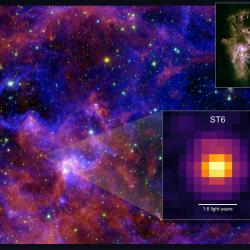Agents of Exploration
These University of Maryland alumni spend their days exploring the cosmos.
John Mulchaey
For some, the tug of supermassive black holes can be felt in a more figurative sense. John Mulchaey, Ph.D. ’94, astronomy, studied active galaxies and supermassive black holes as a doctoral student. Positions as a postdoctoral researcher and then a staff astronomer at the Carnegie Observatories saw him shift his research focus to how galaxies evolve and change over time. Recently, Mulchaey returned to his roots and the study of supermassive black holes. “I’m very excited about a new project where we will search for these black holes in the smallest galaxies we know of,” Mulchaey says. He’ll balance this research program along with his responsibilities as director of the Carnegie Observatories, a promotion made official in April 2015.
KwangHo Park
KwangHo Park, Ph.D. ‘12, astronomy, is deeply involved in the study of black hole origins. Now a postdoctoral researcher at Georgia Tech, he participates in the Theoretical and Computational Astrophysics Network and models the growth of supermassive black holes. His main concern is how active galactic nuclei balance the forces of gas accretion in “brightest cluster galaxies,” home to the most massive black holes in the universe. “I hope we can get a better answer to one of the biggest mysteries,” Park says. “How do massive black holes form and grow in both the early and present-day universe?”
Amy Reines
Some great careers emerge in unexpected ways. Amy Reines, B.S. ’98, astronomy, didn’t set out to study science, instead starting off as a business major. Reines changed her major after getting hooked on Grace Deming’s Astronomy 101 class. After completing a couple of master’s degrees and founding a startup in math tutoring, she earned a Ph.D. in astronomy from the University of Virginia in 2011. “I unexpectedly found a supermassive black hole in a dwarf starburst galaxy and that completely changed my research focus,” Reines says. Following her doctoral studies, Reines was awarded a NASA Einstein Fellowship at the National Radio Astronomy Observatory and began a NASA Hubble Fellowship at the University of Michigan last year.
R. Brent Tully
In 1977, shortly after accepting a position at the University of Hawaii, R. Brent Tully, Ph.D. ‘72, astronomy, published a landmark paper with J. Richard Fisher, Ph.D. ‘72, astronomy, which proposed a relationship between the masses of galaxies and their luminosities. The Tully-Fisher relation, which remains a standard tool for astronomers, has enabled the measurement of distances between Earth and far-flung galaxies. “When I started graduate studies in 1964, I saw immediately that astronomy was wide open,” Tully says. “Little was known and the competition was limited.” Tully has published numerous catalogs of nearby galaxies, and in 2014 shared the Gruber Foundation Cosmology Prize for discoveries regarding the structure of our universe, governed by an invisible gravitational component—what we now call dark matter.
Writer: Matthew Wright
See also:







